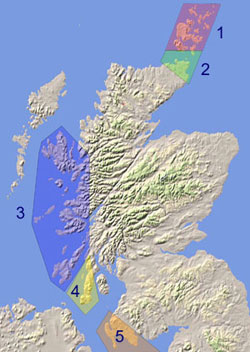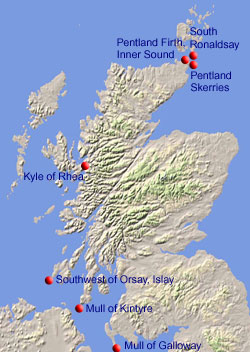


| Summary |
Locations Resource Exploitation
Locations
Scotland has an abundant Marine Current energy resource, powered by the strong tidal currents experienced around the Scottish coastline.
The key coastal areas of high-tidal velocities were identified:
- Orkney & Shetland
- Pentland Firth
- West Scotland
- Kintyre
- Galloway
 |
 |
back to top
Resource exploitation
The proposed Baseload Supply Strategy combines the variable output from several Marine Current Turbine schemes located around the Scottish coastline. Pumped storage is used when the total energy generated is in excess of the target baseload to store the excess energy. When the total generation falls below the target level, then the energy stored can be released to fill in the gaps and maintain a flat baseload.
The rotation of the moon around the earth gives rise to tides which power the 12.4-hour cycle of the incoming and outgoing tide. The velocity of the tidal streams at a given location can be assumed to behave like a sinusoidal curve against time.
A tidal stream or marine current energy capture device installed at a single site will, therefore, generate a variable supply of energy as the tide flows in and out and will not generate a constant supply.
The times of high water and low water change with longitude. The time of maximum tidal velocity (experienced approximately halfway between high-water and low-water) and the time of minimum velocity (at slack water) are therefore different for various locations around Scotlandís coastline.
This study selected an appropriate energy capture technology, predicted the varying power output from several Marine Current Turbine farms located around Scotland and investigated whether the output from multiple schemes could be combined into a strategy to provide a constant source of energy, that could meet a proportion of Scotlandís baseload demand.
This study has proven that baseload can be provided from combining multiple marine current energy developments together with pumped storage. For example:
- The first strategy scenario, which selected the Ďoptimalí installed capacity of marine current turbines aiming to minimise the amount of pumped storage required, generated a baseload of 433.5MW using an 871MW of MCT units giving a capacity factor of 0.41.
- The second scenario, which installed the maximum number on units possible in the areas available, increasing the storage requirement to a maximum, generated a baseload of 881MW using 1768MW of MCT giving a capacity factor of 0.43.